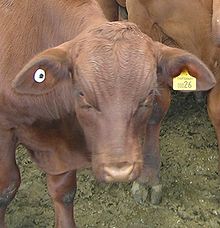National Livestock Identification System
- National Livestock Identification System
-

White NLIS RFID tag and a yellow herd management tag
The National Livestock Identification System (NLIS) is a livestock identification and tracking system used in Australia.
The system uses RFID devices to identify and track livestock and keeps a central electronic database of an animal’s residency and animals it has interacted with.[1] The government claims the system improves food safety and access to export markets, and assists with disease management. Farmers must register their property if they hold one or more heads of livestock including cattle, sheep, goats, pigs, deer and camels,[2] though the NLIS will not confirm ownership of livestock.[3] The system originates from a cattle-tracing system introduced in Australia in the 1960s to help fight bovine tuberculosis.[4]
The NLIS RFID system was introduced in New South Wales on 1 July 2004 and replaced the previous tail tag system for cattle. The approved devices used are the commonly used ear tags or alternatively a rumen bolus.[5]
Similar systems exist in other countries such as the National Animal Identification System in the United States, the British Cattle Movement Service and the proposed National Animal Identification and Tracing in New Zealand.
See also
References
Wikimedia Foundation.
2010.
Look at other dictionaries:
National Livestock Identification System — noun a system for livestock identification and traceability, allowing individual animals to be identified electronically from implanted or attached identification devices, and tracked from the property at which they were born to the location of… …
National Animal Identification System — The National Animal Identification System, (NAIS) is a government run program in the United States intended to extend government animal health surveillance by identifying and tracking specific animals.[1] Administered at the federal level by the… … Wikipedia
National Animal Identification and Tracing — (NAIT) is a system being developed to identify and track livestock in New Zealand. The scheme is to be used for tracing the history of animals from farms to abattoirs using radio frequency identification (RFID) technology. Federated Farmers, a… … Wikipedia
Livestock — For other uses, see Livestock (disambiguation). Domestic sheep and a cow (heifer) pastured together in South Africa Livestock refers to one or more domesticated animals raised in an agricultural setting to produce commodities such as food, fiber… … Wikipedia
National Guard of the United States — For the National Guard of a State and other countries National Guard, see National Guard (disambiguation). For the American Civil War regiment, see 11th New York Volunteer Infantry Regiment. National Guard of the United States … Wikipedia
NLIS — National Livestock Identification System …
Ear tag — An Ear tag is a plastic or metal object used for identification of domestic livestock and other animals. If the ear tag contains an RFID module conforming to ISO 11784 11785, then it is called an Electronic Ear Tag.An ear tag usually carries the… … Wikipedia
Microchip implant (animal) — For use in humans, see Microchip implant (human). Microchip implant in a cat. A microchip implant is an identifying integrated circuit placed under the skin of a dog, cat, horse, parrot or other animal. The chips are about the size of a large… … Wikipedia
Murray Grey — cows and a calf in snow, Walcha NSW A silver grass fed M … Wikipedia
U.S. Food and Drug Administration — Infobox Government agency agency name = Food and Drug Administration parent agency = logo width = 200px logo caption = FDA Logo formed = 1906 [cite web|url=http://www.fda.gov/centennial/|title=FDA Centennial 1906 2006|accessdate=2008 09… … Wikipedia

